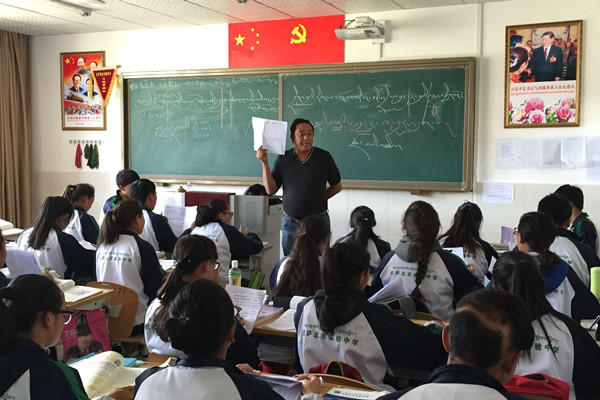 |
|
Students from the Tibet autonomous region follow a Tibetan-language lesson at the Lhasa-Beijing Experimental Middle School in Lhasa. [Photo by Zhang Yi/China Daily] |
The Lhasa-Beijing Experimental Middle School last year sent more than 80 percent of its graduates on to higher education, a remarkable feat for a fledgling institution that just opened a year ago.
The bilingual school is a model for educational cooperation between Lhasa, the capital of the Tibet autonomous region, and other cities in China. It received construction funding of 220 million yuan ($35 million) from the Beijing municipal government.
The school in Lhasa educates 2,427 students, with 96 percent from rural areas who belong to the Tibetan ethnic group, and is a home to them too as most live on the expansive campus.
For these students, both their tuition and accommodation are free, said Zhang Zhihong, deputy principal. Meals and school uniforms also are provided, through funding of about 300 yuan per student per month from the central government.
Beijing, which has been a major patron of Lhasa for more than 20 years, helped build the school last year and contributes considerably to the teaching staff, said Zhang. He was the deputy principal at Cuiwei Middle School, an affiliate of Peking University, before he was appointed to the Lhasa middle school.
Fifty highly experienced teachers from well-regarded middle schools in Beijing account for half of the teaching staff. Other instructors, who mainly teach classes related to the Tibetan language, culture and expertise are hired from within the region.
The work of the Beijing teachers was instrumental in preparing so many graduates for colleges, universities and trade schools, said Ji Yunpeng, deputy head of the Lhasa Education and Sports Administration Bureau.
"The teachers are selected from a wide range of schools in Beijing and are adept at imparting knowledge to students according to their individual capabilities. They helped innovate teaching methods, brought the latest notions in education and greatly improved the students' marks in various exams," Ji said.
Beijing also has invested in about 10 other schools in Lhasa and sent more than 70 teachers to them over the past 20 years.
Seventeen other cities and provinces lend Tibet a helping hand with education.
In addition, 17 State-owned enterprises, 27 institutions of higher education and 15 entities that are part of the Ministry of Education have partnerships with the region. Tibet received 1.4 billion yuan in aid and built 678,000 square meters of educational facilities from 2010 to 2014, the region's educational authority said.
Aid for Tibetan education, which began flowing in June 2001, has played an important role in eliminating illiteracy.
By the end of last year, illiteracy among the young and middle-aged was a mere 0.57 percent and the number of people deemed illiterate was 12,000. Before the region was liberated from serfdom in 1951, it had an illiteracy rate of 95 percent.
The 2013 guidelines for educational assistance in Tibet created partnerships between 27 institutions of higher education and six colleges and universities in Tibet.
One of the chief aims of the central government is to ensure that the families of young Tibetans are not financially burdened by sending their children to school. Nine years of education are required.
In 2007, Tibet became the first place in the country to enjoy free nine-year compulsory education, and in 2012 it was the first place in China where students were entitled to 15 years of free education.
In the years between 1985 and 2014, the exemption of fees for tuition, room and board for the offspring of farmers and herders benefited 550,000 students.
Contact the writers through zhang_yi@chinadaily.com.cn
